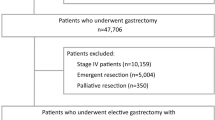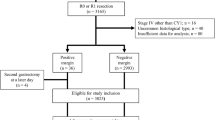Abstract
Background
Most previous studies concerning the impact of positive margins on patient outcomes were based on patients with D1 lymphadenectomy. The prognostic significance of positive margins for patients with D2/D3 lymphadenectomy has not been investigated.
Methods
Clinicopathologic and prognostic data were compared between 110 patients with positive margins and 2,159 patients with negative margins who underwent R0 surgery (D2/D3 lymphadenectomy). Multivariate analysis was performed to identify independent factors correlated with positive margins. Cox’s proportional hazard model was applied to investigate whether a positive margin was an independent factor predicting poor outcome. Overall survival rates and the incidence of recurrence were compared between patients with positive and negative margins, stratifying by pT, pN, and TNM stage.
Results
Tumor size, pT stage, and pN stage were independent factors associated with positive margins. Although the overall survival rate of patients with positive margins was significantly poorer than that of patients with negative margins, margin status was not an independent prognostic factor on multivariate analysis. Significant differences in survival between patients with negative and positive margins could be observed for those in pT1-2, pN0-1, and I–II stage, but not for those in pT3-4, pN2-3, and III–VI stage. Although locoregional recurrence was more frequently observed for patients with positive margins, the incidence of any recurrence was significantly higher only for patients in pT1-2, pN0-1, and I-II stage, but not for those in pT3-4, pN2-3, and III–VI stage.
Conclusion
A positive margin results in a significantly worse outcome for pT1-2, pN0-1, and I–II stage gastric cancer patients who undergo D2/D3 lymphadenectomy, but not for those in pT3-4, pN2-3, and III–IV stage.



Similar content being viewed by others
References
Jemal A, Siegel R, Ward E, et al. Cancer statistics, 2008. CA Cancer J Clin. 2008;58:71–96.
Goggins WB, Wong GK. Poor survival for US Pacific Islander cancer patients: evidence from the Surveillance, Epidemiology, and End Results database: 1991 to 2004. J Clin Oncol. 2007;25:5738–41.
Crew KD, Neugut AI. Epidemiology of gastric cancer. World J Gastroenterol. 2006;12:354–62.
Sobin LH, Wittekind C. TNM classification of malignant tumors, 5th ed. New York: Wiley; 1997.
Songun I, Bonenkamp JJ, Hermans J, et al. Prognostic value of resection line involvement in patients undergoing curative resection for gastric cancer. Eur J Cancer. 1996;32A:433–7.
Kakeji Y, Tsujitani S, Baba H, et al. Clinicopathologic features and prognostic significance of duodenal invasion in patients with distal gastric carcinoma. Cancer. 1991;68:380–4.
Papachristou DN, Agnanti N, D’Agostino H, et al. Histologically positive esophageal margin in the treatment of gastric cancer. Am J Surg. 1980;139:711–3.
Cascinu S, Giordani P, Catalano V, et al. Resection-line involvement in gastric cancer patients undergoing curative resections: implications for clinical management. Jpn J Clin Oncol. 1999;29:291–3.
Kim SH, Karpeh MS, Klimstra DS, et al. Effect of microscopic resection line disease on gastric cancer survival. J Gastrointest Surg. 1999;3:24–33.
Morgagni P, Garcea D, Marrelli D, et al. Resection line involvement after gastric cancer surgery: clinical outcome in nonsurgically retreated patients. World J Surg. 2008;32:2661–7.
Siewert JR, Bittcher K, Stein HJ, et al. Relevant prognostic factors in gastric cancer: ten-year results of the German Gastric Cancer Study. Ann Surg. 1998;228:449–61.
Dicken BJ, Bigam DL, Cass C, et al. Gastric adenocarcinoma: review and considerations for future directions. Ann Surg. 2005;241:27–39.
Kim JP, Lee JH, Kim SJ, et al. Clinicopathologic characteristics and prognostic factors in 10,783 patients with gastric cancer. Gastric Cancer. 1998;1:125–33.
Bonenkamp JJ, Hermans J, Sasako M, et al. Extended lymph-node dissection for gastric cancer. N Engl J Med. 1999;340:908–14.
Roviello F, Marrelli D, Morgagni P, et al. Survival benefit of extended D2 lymphadenectomy in gastric cancer with involvement of second level lymph nodes: a longitudinal multicenter study. Ann Surg Oncol. 2002;9:894–900.
Greene FL, Page DL, Fleming ID, et al. AJCC cancer staging manual, 6th ed. New York: Springer; 2002.
Hallissey MT, Jewkes AJ, Dunn JA, et al. Resection-line involvement in gastric cancer: a continuing problem. Br J Surg. 1993;80:1418–20.
Yokota T, Sawai K, Yamaguchi T, et al. Resection margin in patients with gastric cancer associated with esophageal invasion: clinicopathological study. J Surg Oncol. 1993;53:60–3.
Park JM, Jang YJ, Kim JH, et al. Gastric cancer histology: clinicopathologic characteristics and prognostic value. J Surg Oncol. 2008;98:520–5.
Kasakura Y, Fujii M, Mochizuki F, et al. Clinicopathological features of the superficial spreading type of early gastric cancer. Gastric Cancer. 1999;2:129–35.
Rosenberg R, Nekarda H, Bauer P, et al. Free peritoneal tumour cells are an independent prognostic factor in curatively resected stage IB gastric carcinoma. Br J Surg. 2006;93:325–31.
Majima T, Ichikura T, Mochizuki H. Prognostic significance of the cytologic features of free cancer cells in the peritoneal cavity of patients with gastric cancer. Surg Today. 2002;32:35–9.
Suzuki T, Ochiai T, Hayashi H, et al. Peritoneal lavage cytology findings as prognostic factor for gastric cancer. Semin Surg Oncol. 1999;17:103–7.
Maehara Y, Hasuda S, Koga T, et al. Postoperative outcome and sites of recurrence in patients following curative resection of gastric cancer. Br J Surg. 2000;87:353–7.
Kodera Y, Nakanishi H, Ito S, et al. Quantitative detection of disseminated free cancer cells in peritoneal washes with real-time reverse transcriptase–polymerase chain reaction: a sensitive predictor of outcome for patients with gastric carcinoma. Ann Surg. 2002;235:499–506.
Bonenkamp JJ, Hermans J, Sasako M, et al. Extended lymph-node dissection for gastric cancer. N Engl J Med. 1999;340:908–14.
Roviello F, Marrelli D, Morgagni P, et al. Survival benefit of extended D2 lymphadenectomy in gastric cancer with involvement of second level lymph nodes: a longitudinal multicenter study. Ann Surg Oncol. 2002;9:894–900.
Wu CW, Hsiung CA, Lo SS, et al. Stage migration influences on stage-specific survival comparison between D1 and D3 gastric cancer surgeries. Eur J Surg Oncol. 2005;31:153–7.
Author information
Authors and Affiliations
Corresponding author
Additional information
Zhe Sun and De-ming Li contributed equally to this work.
Rights and permissions
About this article
Cite this article
Sun, Z., Li, Dm., Wang, Zn. et al. Prognostic Significance of Microscopic Positive Margins for Gastric Cancer Patients with Potentially Curative Resection. Ann Surg Oncol 16, 3028–3037 (2009). https://doi.org/10.1245/s10434-009-0624-0
Received:
Accepted:
Published:
Issue Date:
DOI: https://doi.org/10.1245/s10434-009-0624-0




